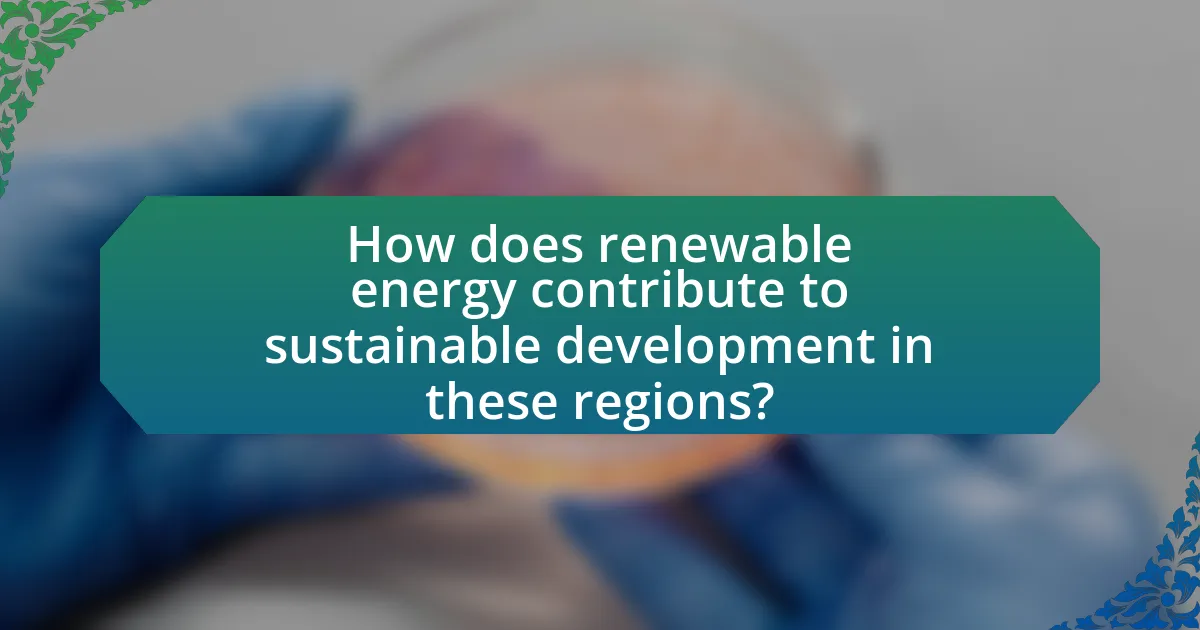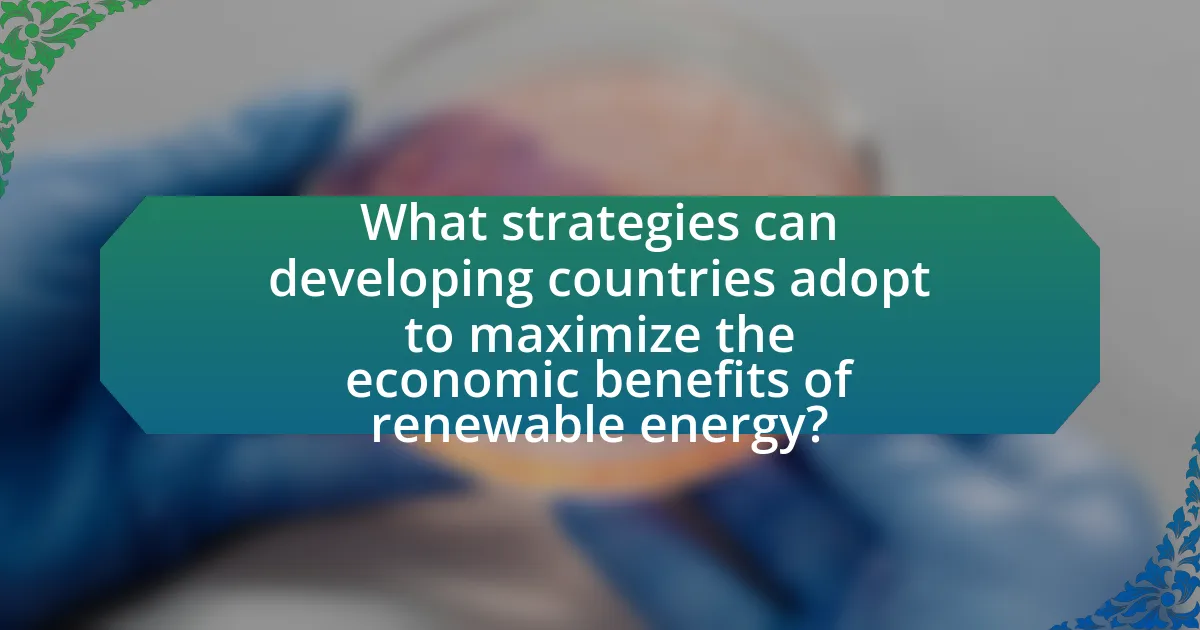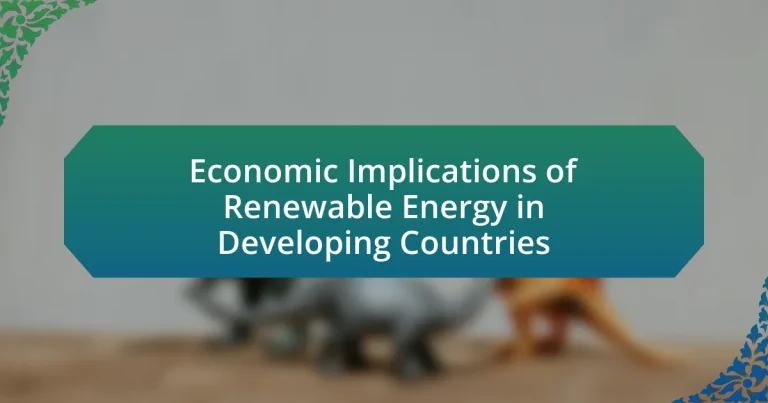The article examines the economic implications of renewable energy in developing countries, highlighting its potential for job creation, energy independence, and reduced energy costs. It discusses how transitioning to renewable sources, such as solar and wind, can stimulate local economies and enhance energy security while addressing key economic indicators like employment rates and GDP growth. The article also explores the challenges faced by developing nations in adopting renewable energy, including financial barriers and inadequate infrastructure, and emphasizes the importance of international partnerships and supportive regulatory frameworks in overcoming these obstacles. Additionally, it outlines the long-term benefits of renewable energy investments, including improved public health and environmental sustainability, ultimately contributing to sustainable development in these regions.

What are the Economic Implications of Renewable Energy in Developing Countries?
The economic implications of renewable energy in developing countries include job creation, energy independence, and reduced energy costs. Transitioning to renewable energy sources, such as solar and wind, can generate millions of jobs; for instance, the International Renewable Energy Agency reported that the renewable energy sector employed over 11 million people globally in 2018, with a significant portion in developing regions. Additionally, renewable energy can enhance energy independence by reducing reliance on imported fossil fuels, which often leads to volatile prices and economic instability. Furthermore, the cost of renewable energy technologies has decreased dramatically; the levelized cost of electricity from solar photovoltaics fell by 89% between 2009 and 2020, making it a more affordable option for many developing countries. These factors collectively contribute to economic growth and sustainability in these regions.
How does renewable energy impact economic growth in developing countries?
Renewable energy positively impacts economic growth in developing countries by providing affordable and sustainable energy solutions that stimulate local economies. Access to renewable energy sources, such as solar and wind, reduces reliance on imported fossil fuels, which can be costly and volatile. For instance, the International Renewable Energy Agency (IRENA) reported that renewable energy could create up to 24 million jobs globally by 2030, with a significant portion of these opportunities arising in developing nations. Furthermore, investments in renewable energy infrastructure can enhance energy security, attract foreign investment, and promote technological innovation, all of which contribute to economic development.
What are the key economic indicators affected by renewable energy adoption?
The key economic indicators affected by renewable energy adoption include employment rates, energy prices, and GDP growth. Employment rates improve as renewable energy sectors, such as solar and wind, create jobs in manufacturing, installation, and maintenance; for instance, the International Renewable Energy Agency reported that the renewable energy sector employed over 11 million people globally in 2018. Energy prices tend to stabilize or decrease due to the declining costs of renewable technologies, with the levelized cost of electricity from solar and wind falling by 88% and 49% respectively from 2010 to 2019, according to the International Energy Agency. Additionally, GDP growth can be positively influenced as investments in renewable energy infrastructure stimulate economic activity, with a study by the Global Commission on the Economy and Climate indicating that transitioning to a low-carbon economy could generate $26 trillion in economic benefits by 2030.
How does renewable energy influence job creation in these regions?
Renewable energy significantly influences job creation in developing regions by generating employment opportunities in various sectors such as manufacturing, installation, and maintenance of renewable energy technologies. For instance, the International Renewable Energy Agency (IRENA) reported that the renewable energy sector employed over 11 million people globally in 2018, with a substantial portion of these jobs located in developing countries. This growth is driven by investments in solar, wind, and biomass energy projects, which require a skilled workforce for their development and operation. Additionally, the transition to renewable energy often stimulates local economies, leading to indirect job creation in related industries such as transportation and services.
What challenges do developing countries face in adopting renewable energy?
Developing countries face significant challenges in adopting renewable energy, primarily due to financial constraints, inadequate infrastructure, and limited technical expertise. Financially, many developing nations struggle to secure the necessary investment for renewable projects, as evidenced by the International Renewable Energy Agency (IRENA) reporting that global investment in renewable energy reached $282 billion in 2019, with developing countries receiving a fraction of this amount. Infrastructure challenges include the lack of reliable energy grids and distribution systems, which hinder the integration of renewable sources like solar and wind. Additionally, limited technical expertise restricts the ability to implement and maintain advanced renewable technologies, as highlighted by the United Nations Development Programme (UNDP), which emphasizes the need for capacity building in these regions.
What are the financial barriers to renewable energy implementation?
The financial barriers to renewable energy implementation include high initial capital costs, limited access to financing, and perceived investment risks. High initial capital costs for technologies such as solar panels and wind turbines can deter investment, as these upfront expenses often exceed the budgets of developing countries. Limited access to financing arises from underdeveloped financial markets, where banks may lack the capacity or willingness to fund renewable projects due to insufficient collateral or credit history. Additionally, perceived investment risks, including regulatory uncertainties and fluctuating energy prices, can further inhibit private sector investment in renewable energy. According to the International Renewable Energy Agency, these barriers significantly slow down the transition to renewable energy in developing regions, where the need for sustainable energy solutions is critical.
How do regulatory frameworks impact renewable energy investments?
Regulatory frameworks significantly influence renewable energy investments by establishing the legal and financial environment that either encourages or deters investment. For instance, supportive policies such as feed-in tariffs, tax incentives, and renewable energy mandates can attract capital by ensuring stable returns and reducing investment risks. According to the International Renewable Energy Agency (IRENA), countries with clear and consistent regulatory frameworks saw a 50% increase in renewable energy investments from 2010 to 2019. Conversely, ambiguous regulations or frequent policy changes can lead to uncertainty, discouraging investors. This correlation highlights the critical role that well-defined regulatory frameworks play in shaping the investment landscape for renewable energy projects, particularly in developing countries where such frameworks can either catalyze growth or hinder progress.
What role do international partnerships play in renewable energy development?
International partnerships are crucial for renewable energy development as they facilitate technology transfer, funding, and knowledge sharing. These collaborations enable developing countries to access advanced renewable technologies and financial resources, which are often beyond their domestic capabilities. For instance, the International Renewable Energy Agency (IRENA) reported that international cooperation can reduce the cost of renewable energy projects by up to 30% through shared expertise and resources. Additionally, partnerships with developed nations and organizations can enhance local capacity building, ensuring sustainable implementation and maintenance of renewable energy systems.
How can foreign investment enhance renewable energy projects?
Foreign investment can enhance renewable energy projects by providing essential capital, technology transfer, and expertise. This influx of funds enables the development of infrastructure, such as solar farms and wind turbines, which are often capital-intensive. For instance, a report by the International Renewable Energy Agency (IRENA) indicates that investments in renewable energy can lead to a 30% reduction in costs for solar energy projects due to economies of scale and technological advancements. Additionally, foreign investors often bring advanced technologies and best practices that improve efficiency and sustainability in project execution. This combination of financial resources and technological innovation significantly accelerates the deployment of renewable energy solutions in developing countries, ultimately contributing to energy security and economic growth.
What are the benefits of technology transfer in renewable energy?
Technology transfer in renewable energy provides multiple benefits, including enhanced access to advanced technologies, improved energy efficiency, and economic growth in developing countries. By facilitating the adoption of innovative renewable energy technologies, developing nations can reduce their reliance on fossil fuels, leading to lower greenhouse gas emissions and improved environmental sustainability. For instance, the International Renewable Energy Agency (IRENA) reported that technology transfer can significantly lower the costs of renewable energy systems, making them more accessible and affordable. Additionally, technology transfer fosters local job creation and skill development, as seen in countries like India, where solar energy initiatives have generated thousands of jobs in manufacturing and installation. Overall, technology transfer is crucial for accelerating the transition to sustainable energy systems and promoting economic development in emerging economies.

How does renewable energy contribute to sustainable development in these regions?
Renewable energy contributes to sustainable development in developing regions by providing clean, reliable energy sources that reduce dependence on fossil fuels and lower greenhouse gas emissions. This transition not only mitigates climate change but also enhances energy security and promotes economic growth. For instance, the International Renewable Energy Agency reported that renewable energy could create up to 24 million jobs globally by 2030, particularly in developing countries where energy access is limited. Additionally, investments in renewable technologies can stimulate local economies, improve public health by reducing air pollution, and foster innovation in energy solutions tailored to local needs.
What are the environmental benefits of renewable energy in developing countries?
Renewable energy in developing countries significantly reduces greenhouse gas emissions, contributing to climate change mitigation. By replacing fossil fuels with solar, wind, and hydroelectric power, these nations can lower their carbon footprints. For instance, a study by the International Renewable Energy Agency (IRENA) found that transitioning to renewable energy could reduce global CO2 emissions by up to 70% by 2050, with developing countries playing a crucial role in this transition. Additionally, renewable energy sources help improve air quality by decreasing reliance on polluting energy sources, which is vital for public health in densely populated areas.
How does renewable energy reduce carbon emissions?
Renewable energy reduces carbon emissions by replacing fossil fuels with cleaner energy sources such as solar, wind, and hydroelectric power. These renewable sources generate electricity without releasing carbon dioxide, which is a major greenhouse gas contributing to climate change. For instance, according to the International Renewable Energy Agency, transitioning to renewable energy could reduce global carbon emissions by up to 70% by 2050. This significant reduction occurs because renewable energy systems produce energy through natural processes that do not involve combustion, thereby eliminating the carbon emissions associated with burning fossil fuels.
What impact does renewable energy have on local ecosystems?
Renewable energy can positively impact local ecosystems by reducing greenhouse gas emissions and minimizing habitat destruction compared to fossil fuels. For instance, solar and wind energy projects typically require less land and water than traditional energy sources, which helps preserve local biodiversity. Research indicates that transitioning to renewable energy can lead to a decrease in air and water pollution, benefiting both flora and fauna. A study published in the journal “Nature” highlights that renewable energy installations can enhance local wildlife habitats when designed with ecological considerations in mind, demonstrating that careful planning can mitigate potential negative effects.
How does renewable energy improve energy access in rural areas?
Renewable energy improves energy access in rural areas by providing a sustainable and decentralized power source that can be deployed without extensive infrastructure. This is particularly significant in regions where traditional energy grids are absent or unreliable. For instance, solar microgrids and wind turbines can be installed locally, allowing communities to generate their own electricity. According to the International Renewable Energy Agency (IRENA), renewable energy technologies can increase energy access for over 1 billion people globally, particularly in rural settings where conventional energy solutions are economically unfeasible. Furthermore, the use of renewable energy reduces reliance on fossil fuels, which can be costly and logistically challenging to transport to remote areas, thereby enhancing energy security and affordability for rural populations.
What are the economic benefits of increased energy access?
Increased energy access leads to significant economic benefits, including enhanced productivity, job creation, and improved quality of life. Access to reliable energy allows businesses to operate more efficiently, which can increase output and profitability. For instance, a study by the International Energy Agency found that expanding electricity access in sub-Saharan Africa could boost GDP by up to 2.5% annually. Furthermore, energy access fosters job creation in sectors such as manufacturing and services, as businesses expand and new enterprises emerge. Additionally, improved energy access contributes to better education and healthcare services, which further supports economic growth by developing a more skilled workforce and reducing healthcare costs.
How does energy access influence education and healthcare in developing countries?
Energy access significantly enhances education and healthcare in developing countries by providing the necessary infrastructure for effective learning and medical services. Reliable electricity enables schools to operate after dark, facilitating extended study hours and access to digital learning resources, which can improve educational outcomes. For instance, a study by the World Bank found that access to electricity can increase school attendance rates by up to 20%.
In healthcare, energy access is crucial for powering medical equipment, refrigeration for vaccines, and lighting for surgeries, which directly impacts patient care quality. The World Health Organization reports that 1.1 billion people lack access to electricity, leading to inadequate healthcare services and increased mortality rates. Therefore, improving energy access is essential for advancing both education and healthcare in these regions.
What are the long-term economic benefits of investing in renewable energy?
Investing in renewable energy yields significant long-term economic benefits, including job creation, energy independence, and reduced healthcare costs. Job creation is particularly notable; the International Renewable Energy Agency reported that the renewable energy sector employed over 11 million people globally in 2018, with projections indicating continued growth as investments increase. Energy independence reduces reliance on imported fossil fuels, stabilizing local economies and enhancing energy security. Additionally, transitioning to renewable energy sources leads to lower air pollution, which can decrease healthcare costs associated with respiratory and cardiovascular diseases; the American Lung Association estimated that transitioning to clean energy could save the U.S. healthcare system billions annually. These factors collectively contribute to sustainable economic growth in developing countries.
How does renewable energy contribute to energy independence?
Renewable energy contributes to energy independence by reducing reliance on imported fossil fuels. By harnessing local resources such as solar, wind, and hydroelectric power, countries can generate their own energy, thereby enhancing their energy security. For instance, according to the International Renewable Energy Agency (IRENA), countries that invest in renewable energy can decrease their energy import bills significantly, leading to improved economic stability. This shift not only fosters local job creation in the renewable sector but also stabilizes energy prices, further supporting energy independence.
What are the potential savings for governments and consumers?
Governments and consumers can potentially save billions of dollars through the adoption of renewable energy sources. For instance, a report by the International Renewable Energy Agency (IRENA) indicates that transitioning to renewable energy could save governments up to $160 billion annually in health and environmental costs by 2030. Consumers benefit from reduced energy bills, with studies showing that households using solar energy can save between 20% to 50% on their electricity costs. Additionally, renewable energy projects create jobs and stimulate local economies, further enhancing financial savings for both governments and consumers.

What strategies can developing countries adopt to maximize the economic benefits of renewable energy?
Developing countries can maximize the economic benefits of renewable energy by implementing policies that promote investment, enhance local capacity, and foster technology transfer. For instance, establishing favorable regulatory frameworks and financial incentives can attract both domestic and foreign investments in renewable energy projects. According to the International Renewable Energy Agency (IRENA), countries that have adopted such policies have seen significant increases in renewable energy capacity, leading to job creation and economic growth. Additionally, investing in education and training programs can build local expertise, ensuring that communities can effectively manage and maintain renewable energy systems. This approach not only boosts local economies but also enhances energy security and sustainability.
How can governments incentivize renewable energy investments?
Governments can incentivize renewable energy investments by implementing financial mechanisms such as tax credits, grants, and subsidies. For instance, the U.S. federal government offers the Investment Tax Credit (ITC), which allows investors to deduct a significant percentage of the cost of installing solar energy systems from their federal taxes. This has led to a substantial increase in solar installations, with a reported growth of over 167% in solar capacity from 2010 to 2020. Additionally, governments can establish feed-in tariffs that guarantee fixed payments for energy produced from renewable sources, ensuring a stable revenue stream for investors. Countries like Germany have successfully utilized this approach, resulting in a dramatic rise in renewable energy share from 6% in 2000 to over 40% in 2020. These strategies not only attract private investment but also stimulate job creation and economic growth in developing countries.
What types of subsidies or tax incentives are most effective?
Direct cash subsidies and tax credits for renewable energy projects are the most effective types of subsidies and tax incentives. These financial mechanisms provide immediate capital support, reducing the upfront costs associated with renewable energy installations, which is crucial in developing countries where access to financing may be limited. For instance, the U.S. solar investment tax credit has been shown to significantly boost solar installations, leading to a 167% increase in capacity from 2010 to 2019, demonstrating the effectiveness of such incentives in driving renewable energy adoption.
How can public-private partnerships enhance renewable energy projects?
Public-private partnerships (PPPs) can enhance renewable energy projects by leveraging the strengths of both sectors to improve financing, innovation, and implementation efficiency. These collaborations allow for shared investment risks, which can attract private capital to projects that may otherwise be deemed too risky or capital-intensive for public entities alone. For instance, the International Renewable Energy Agency reported that PPPs have facilitated the financing of over 50% of renewable energy projects in developing countries, demonstrating their effectiveness in mobilizing resources. Additionally, PPPs can foster technological innovation by combining public sector regulatory support with private sector expertise and efficiency, leading to more effective and sustainable energy solutions.
What best practices can be implemented for successful renewable energy projects?
Successful renewable energy projects can be achieved by implementing comprehensive stakeholder engagement, rigorous feasibility studies, and adaptive project management. Stakeholder engagement ensures that local communities, governments, and investors are involved in the planning and decision-making processes, which increases project acceptance and support. Rigorous feasibility studies assess the technical, economic, and environmental viability of projects, leading to informed decisions and resource allocation. Adaptive project management allows for flexibility in response to changing conditions and challenges, enhancing project resilience and effectiveness. These practices are supported by case studies showing that projects with strong community involvement and thorough planning have higher success rates, such as the Solar Home Systems program in Bangladesh, which significantly improved energy access and local economies.
How can community involvement improve project outcomes?
Community involvement can significantly improve project outcomes by enhancing local engagement, ensuring that projects meet the actual needs of the community, and fostering a sense of ownership among stakeholders. When communities actively participate in renewable energy projects, they contribute valuable insights that can lead to more effective and sustainable solutions. For instance, a study by the International Renewable Energy Agency (IRENA) found that projects with strong community engagement are 30% more likely to succeed in achieving their objectives. This increased likelihood of success is attributed to better alignment of project goals with community priorities, which ultimately leads to higher satisfaction and support for the initiatives.
What role does education and training play in renewable energy success?
Education and training are critical for the success of renewable energy initiatives, as they equip individuals with the necessary skills and knowledge to implement and manage renewable technologies effectively. A well-trained workforce can enhance the efficiency and reliability of renewable energy systems, leading to increased adoption and innovation in the sector. For instance, a report by the International Renewable Energy Agency (IRENA) indicates that the renewable energy sector could create up to 24 million jobs globally by 2030, emphasizing the importance of education and training in preparing the workforce for these opportunities. Furthermore, targeted training programs can help local communities in developing countries understand and utilize renewable energy solutions, fostering economic growth and sustainability.
What are the key takeaways for policymakers in developing countries regarding renewable energy?
Policymakers in developing countries should prioritize the integration of renewable energy to enhance economic growth and energy security. Transitioning to renewable sources, such as solar and wind, can reduce dependency on imported fossil fuels, which often leads to volatile energy prices and economic instability. For instance, the International Renewable Energy Agency reported that renewable energy could create up to 24 million jobs globally by 2030, providing significant employment opportunities in developing regions. Additionally, investing in renewable energy infrastructure can stimulate local economies, attract foreign investment, and improve energy access for underserved populations, ultimately contributing to sustainable development goals.
How can policymakers ensure sustainable economic growth through renewable energy?
Policymakers can ensure sustainable economic growth through renewable energy by implementing supportive regulations, investing in infrastructure, and promoting research and development. For instance, countries that have adopted feed-in tariffs and renewable portfolio standards have seen significant increases in renewable energy capacity, which in turn stimulates job creation and economic activity. According to the International Renewable Energy Agency, the renewable energy sector employed over 11 million people globally in 2018, demonstrating the potential for job growth in this field. Furthermore, investing in renewable energy infrastructure can reduce dependence on imported fossil fuels, leading to improved energy security and economic stability.
What lessons can be learned from successful renewable energy initiatives globally?
Successful renewable energy initiatives globally demonstrate the importance of government policy support, community engagement, and technological innovation. For instance, countries like Germany and Denmark have effectively implemented feed-in tariffs and subsidies, which incentivize investment in renewable technologies, leading to significant increases in renewable energy capacity. According to the International Renewable Energy Agency (IRENA), Germany’s renewable energy sector employed over 300,000 people by 2020, showcasing the economic benefits of supportive policies. Additionally, community involvement in projects, such as wind farms in Scotland, has fostered local acceptance and investment, resulting in sustainable energy solutions that benefit both the environment and local economies. Furthermore, technological advancements, particularly in solar energy, have reduced costs and improved efficiency, as evidenced by the 89% drop in solar photovoltaic prices from 2010 to 2020, according to the World Bank. These lessons highlight that strategic policy frameworks, community participation, and continuous innovation are critical for the success of renewable energy initiatives.




